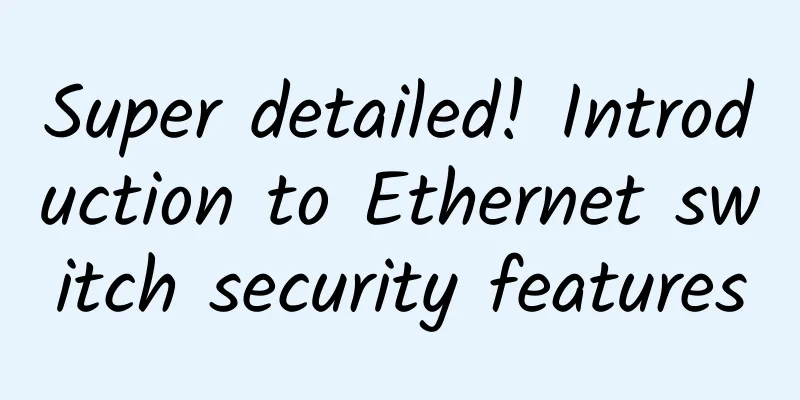Super detailed! Introduction to Ethernet switch security features

|
Today I will talk to you about the security functions of Ethernet switches. As the most common device in the LAN, switches face major security threats. Some of these threats target the management loopholes of switches, and attackers try to control the switches. Some of these threats target the functions of switches, and attackers try to disrupt the normal operation of switches, thereby destroying or even stealing data. Attacks against switches mainly fall into the following categories:
Switch access security To prevent the switch from being detected or controlled by attackers, basic security must be configured on the switch:
Switch port security The switch relies on the MAC address table to forward data frames. If the MAC address does not exist, the switch forwards the frame to every port on the switch (flooding). However, the size of the MAC address table is limited. MAC flooding attacks exploit this limitation by bombarding the switch with false source MAC addresses until the switch MAC address table becomes full. The switch then enters a mode called "fail-open" and begins to act like a hub, broadcasting packets to all machines on the network. Therefore, the attacker can see all frames sent to another host that does not have an entry in the MAC address table. To prevent MAC flooding attacks, you can configure the port security feature to limit the number of valid MAC addresses allowed on the port and define the port's action when an attack occurs: close, protect, or limit. DHCP Snooping When DHCP-Snooping is turned on on the switch, it will snoop on DHCP messages and extract and record the IP address and MAC address information from the received DHCP Request or DHCP Ack messages. In addition, DHCP-Snooping allows a physical port to be set as a trusted port or an untrusted port. A trusted port can normally receive and forward DHCP Offer messages, while an untrusted port will discard the received DHCP Offer messages. In this way, the switch can shield the fake DHCP server and ensure that the client obtains the IP address from the legitimate DHCP server.
DAI Dynamic ARP Inspection (DAI) can prevent ARP spoofing by helping to ensure that access switches only pass "legitimate" ARP request and reply information. DAI works based on DHCP Snooping. DHCP Snooping monitors the binding table, including the binding information of IP address and MAC address, and associates it with a specific switch port. Dynamic ARP Inspection (DAI-Dynamic ARP Inspection) can be used to check the ARP requests and responses (active ARP and passive ARP) of all untrusted ports to ensure that the response comes from the real MAC owner. The switch determines whether it is the real MAC owner by checking the DHCP binding information recorded in the port and the IP address of the ARP reply. Illegal ARP packets will be rejected and forwarded. DAI is configured for VLAN. For interfaces in the same VLAN, DAI can be enabled or disabled. If the ARP packet is received from a trusted interface, no check is required. If the ARP packet is received from an untrusted interface, the packet can only be forwarded if the binding information is proven to be legitimate. In this way, DHCP Snooping becomes essential for DAI. DAI is used dynamically, and the connected client hosts do not need to make any configuration changes. For servers that do not use DHCP, individual machines can be implemented by statically adding DHCP binding tables or ARP access-lists. In addition, DAI can be used to control the ARP request message frequency of a certain port. Once the ARP request frequency exceeds the preset threshold, the port will be closed immediately. This function can prevent the use of network scanning tools and can also block viruses or attacks with a large number of ARP message characteristics. |
<<: 5G will be fully rolled out in 2020. Are 5G network and 5G frequency band the same thing?
>>: 50% of CIO panel members predict that 5G will drive the development of the Internet of Things
Recommend
Why is it necessary to change the RAN architecture?
First, we need to know why we need to evolve from...
How to unleash greater potential of new infrastructure
Recently, several domestic mobile communication o...
Life is not easy, where is the future for terminal manufacturers in the 5G era?
From the 1G analog communication era to the 4G mo...
Borei Data reshapes APM and sets a new benchmark for IT operations and maintenance
With the rise of new-generation information techn...
How 5G will help wearable devices like smartwatches charge automatically
[[435239]] In Japan, a trial project to wirelessl...
5 web trends you need to know about in 2021
On December 14, 2020, a massive network outage ca...
What are the characteristics and uses of Category 7 (Cat7) cables?
Today, demand for faster Internet and data transm...
Review of 5G standards in 2020: R16 standard freezes and improves capability triangle, opening a "new era" for commercial use
[[374016]] In order to better review the gratifyi...
The inspiration of Neusoft's Internet of Vehicles security
Neusoft Network Security, which has been working ...
F5 Releases 2020 State of Application Services Report (APAC Edition) Interpreting Five Major Findings in Enterprise Digital Transformation
[51CTO.com original article] F5 Networks recently...
Microsoft and D-Link jointly launch "SUPER WiFi" to build next-generation networks
Recently, IT giant Microsoft announced a partners...
What to do if the HTTPS certificate is forged?
The security of the HTTPS protocol relies on its ...
Health and Risk: A New Model for Data Center Capacity Management
Some analysis companies believe that capacity man...
80VPS: AMD Ryzen+NVMe products and new platforms are 50% off, and annual payment starts from 349 yuan in Los Angeles Cera data center
80VPS is a long-established Chinese hosting compa...
165 million! China Mobile’s 5G user number announced, is 4G really outdated?
[[377452]] On January 20, China Mobile announced ...









